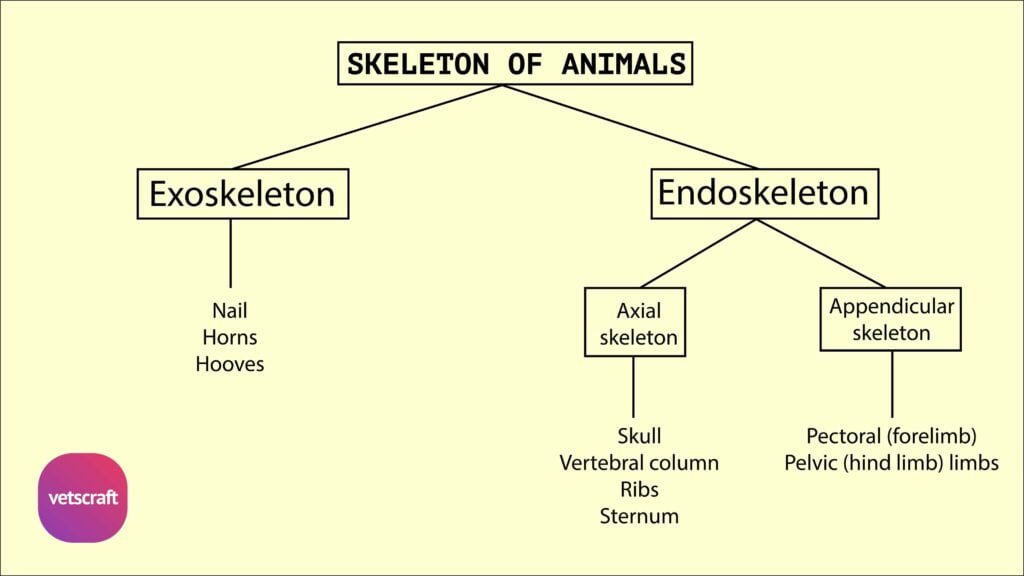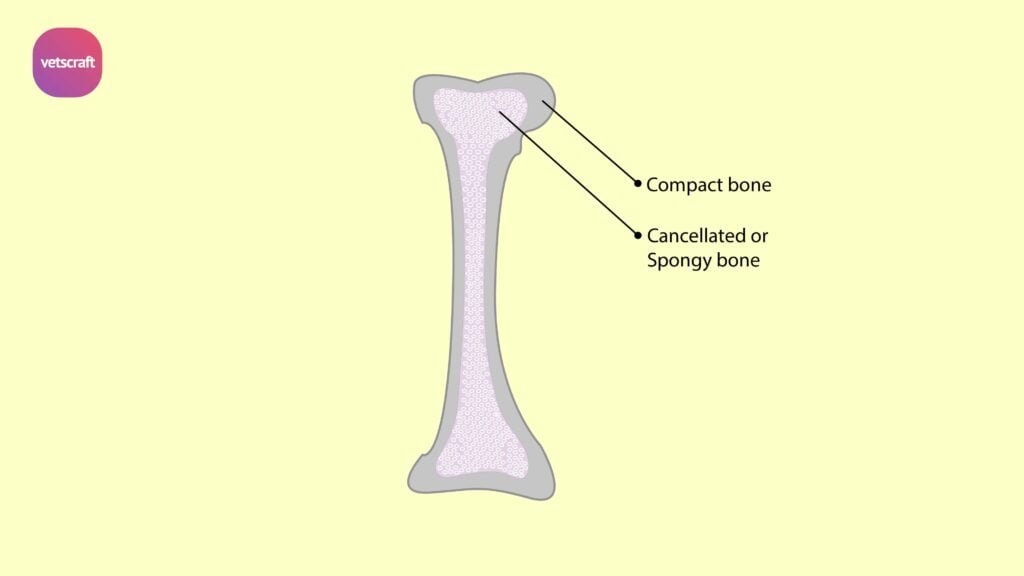TABLE OF CONTENTS
Larynx of Animals
The larynx of Animals is a short musculo-cartilaginous tube, which connects the pharynx with the trachea. It is a valvular apparatus, which regulates the amount of air and is the organ of voice.
Larynx of Ox
Larynx of Ox is situated partly between the two vertical rami of mandible and medial pterygoid muscles and partly between the two parotid salivary glands.
Larynx of Ox is related dorsally to pharynx and oesophagus; Ventrally to skin, fascia, sternothyrohyoideus and omohyoideus muscles; Laterally, to parotid and submaxillary salivary glands and medially pterygoid muscle, digastricus and stylohyoideus muscles.
It is attached to the body and thyroid cornua of the hyoid bone and the pharynx. The cavity communicates above with the pharynx and behind with the trachea.
The larynx is made up of a framework of cartilages connected by ligaments and moved by muscles and is lined internally by mucous membrane.
The cartilages are cricoid, thyroid, arytenoid and epiglottis. Of these, the arytenoids are paired, and the others unpaired.
CARTILAGES OF LARYNX

Cricoid cartilage
- The cricoid cartilage is a ring shaped cartilage
- It consists of a dorsal part- the lamina and ventral and lateral parts -the arches
- The lamina is broad and thick and is marked by a large median ridge
- On either side of this ridge are two facets, the cranial of which articulates with the arytenoids and the caudal with the caudal cornua of thyroid cartilage
- Both the articulations are syndesmoses. The arches are curved and each presents a groove on the lateral surface for the crico-thyroid muscle
- The cranial border gives attachment to thyroid cartilage by the cricothyroid membrane while the caudal border gives attachment to first ring of trachea by the crico-tracheal membrane
- The internal surface is lined by mucous membrane
Thyroid cartilage
- The thyroid cartilage is a shield-shaped cartilage
- It consists of a central part, the body and two lateral parts- the laminae
- The body is attached to the base of the epiglottis by the thyro-epiglottic ligament
- The body shows a prominence ventrally, the laryngeal prominence
- The laminae form the sides of larynx and unite completely on the ventral aspect to form a long plate, which is notched in front, and behind
- It presents two cornua on either side: the cranial and caudal cornua
- The cranial cornua articulates with the thyroid cornua of the hyoid bone by syndesmoses and the caudal cornu with the facet on the caudal part of the lamina of the cricoid cartilage again by syndesmoses
- The cranial cornua presents below its upper border a thyroid notch or foramen for the passage of the cranial laryngeal nerve
Arytenoid cartilages
- The arytenoid cartilages are paired and each is situated dorsally, in front of the cricoid, partly medial and dorsal to the lamina of the thyroid cartilage
- It is pyramidal in form and presents three surfaces (medial, dorsal and lateral) three borders (cranial, caudal and lateral), a base and an apex
- The base faces backward and articulates with cricoid. The apex is in front and curves upwards and backwards
- The cranial and caudal borders converge ventrally to form the vocal process. The process is so named because it furnishes attachment to vocal ligament
- The medial angle of the base is attached to its fellow by a transverse arytenoid ligament
Epiglottis
- The epiglottis is short, leaf-like plate of cartilage placed above the body of the thyroid. It presents two surfaces, two borders, a base and an apex
- The surfaces are oral and pharyngeal surface. The borders are thin, irregular and somewhat everted. The base is caudal, attached to the thyroid cartilage
- The apex is cranial and the tip is free rounded and curves towards the root of the tongue. The surfaces are lined by mucous membrane.
- The cricoid and thyroid cartilages and the greater part of the arytenoid cartilages are hyaline in nature
- The apices, vocal processes of the arytenoid and the epiglottis consist of elastic cartilage. They show no tendency towards ossification at any age
JOINTS, LIGAMENTS AND MEMBRANES OF LARYNX
- The joints formed by the cartilages of the larynx are,
- Cricothyroid between the cricoid and caudal cornu of the thyroid (syndesmoses)
- Crico-arytenoid between the cricoid and bases of the arytenoid (syndesmoses)
- Thyro – hyoid between the cranial cornu of the thyroid and thyroid cornu of the hyoid bone (syndesmoses)
- The chief ligaments are,
- Hyo-epiglottic which attaches the lower part of the oral surface of the epiglottis to the body of the hyoid bone
- Thyro – epiglottic which connects the base of the epiglottis with the body and adjacent medial surfaces of the laminae of thyroid
- The transverse arytenoid which connects the medial angles of the bases of the arytenoid
- The vocal ligament (caudal thyro-arytenoid) underlies and is intimately adherent to the mucous membrane of the vocal fold
- It is attached to the vocal process of the arytenoid and the body of the thyroid
- The ventricular(cranial thyro-arytenoid) ligament is included in the ventricular fold
- It passes from the thyro- epiglottic ligament to the vocal process of the arytenoid. It is poorly developed
- The chief membranes of the larynx are,
- The cricothyroid between the arch of the cricoid and the body of the thyroid
- Thyro – hyoid membrane between the cranial border of the thyroid cartilage and thyroid cornua of the hyoid bone
- Crico – tracheal membrane connects the cricoid and first ring of the trachea
CAVITY OF LARYNX
- The cavity of the larynx is much smaller than one would naturally expect, from its external appearance. On looking into it through the pharyngeal end, narrow folds are seen, projecting from each lateral wall. These are the vocal folds
- The narrow part of the cavity between the vocal folds is the rima glottidis
- The cavity consists of three parts – the auditus laryngis, vestibule and the caudal compartment
- The auditus laryngis or pharyngeal aperture is a large, oblique, oval opening which faces into the ventral part of the pharynx
- It is bounded in front by the epiglottis above and behind by arytenoid cartilages and laterally by the aryepiglottic folds of mucous membrane, which stretch between the edges of the epiglottis and arytenoid cartilages.
- The vestibule of the larynx extends from the auditus laryngius to the vocal folds
- On its lateral walls are the very faint elevations covering the ventricular ligament and called the ventricular folds or false vocal cords
- Between the ventricular and vocal folds on each side is a very faint depression corresponding to the lateral ventricle of the horse
- The middle narrow part of the cavity is termed the glottis or rima glottis
- It is bounded on either side by the vocal folds and the medial faces of the arytenoid cartilages
- The vocal folds or true vocal cords are the fold of mucous membrane projecting from the lateral wall of the cavity of the larynx and are responsible for the production of voice
- The vocal folds covering the vocal ligaments. In ordinary breathing, the rima is lanceolate in form; when dilated, it is diamond shaped
- The widest part being between the vocal processes. The narrow part of the glottis between the vocal cords is termed the pars intermembranaecea, while the wider part between the arytenoid cartilages is the pars intercartilaginea.
- The caudal compartment of the laryngeal cavity is directly continuous with the trachea
- It is enclosed by the cricoid cartilage and the cricothyroid membrane. It is oval in form.
- The mucous membrane of the larynx is reflected around the margin of the auditus and become continuous with that of pharynx and is continuous behind with that which lines the trachea
Larynx of Sheep and Goat
Larynx of Sheep and Goat is same as of larynx of ox.
Larynx of Horse
- Cricoid is clearly ring shaped
- Thyroid cartilage is incomplete ventrally, as the lamina fails to meet below to form the body
- The epiglottis is long and pointed, and is leaf-like
- Twocuneiform processes extend from the base of the epiglottis upwards and backwards
- The different joints of the larynx are diarthrodial
- The vocal cords are large and glottis is very narrow
- The ventricular folds are more prominent
- The lateral ventricles are much deeper and each leads into a mucous sac–the laryngeal saccule
- The base of the epiglottis shows a small middle ventricle between the lower ends of the vocal folds
Larynx of Pig
- The larynx of pig is remarkable for its great length and mobility
- The cartilages are more loosely attached to each other than in old animals
- Cricoid is thick and compressed laterally. Its lamina is long and narrow
- Thyroid cartilage is very long and the laminae are united ventrally to form a median ridge
- The cranial cornua are absent whereas the caudal one is broad and articulate with cricoid cartilage
- Epiglottis is relatively large and closely attached to hyoid bone than the rest of the larynx
- Arytenoids are very large and are divided into two parts at its extremity
- A median laryngeal recess is present in the floor of the vestibule
- The vestibular folds are absent
- The caudal part of the vocal ligament and the thyroarytenoideus form the bulk of the vocal fold
Larynx of Dog
- Larynx of dog is very short
- Cricoid is wider above
- The epiglottis is quadrilateral
- The separate cuneiform cartilages are large
- The laryngeal saccule is extensive and lies lateral to both true and false vocal cords
Larynx of Rabbit
- The thyroid cartilage forms the greater portion of the larynx
- Cricoid cartilage is small and cylindrical
- A pair of small arytenoid cartilage is at the margin of the glottis
- The epiglottis projects dorsally into the pharynx. The tip of the epiglottis is rounded but bifurcated
Larynx of Fowl
- The larynx of fowl consists of cranial andcaudalparts
- The cranial part of larynx made up of cricoid-epiglottis
- The caudal part is at the point of bifurcation of trachea into two primary bronchi and dilated to form a cartilaginous compartment called syrinx
- It is responsible for the production of voice. The membranes present inside the organ produce the voice
- Between the bronchial openings is a ridge, the carnia and this presents on each side an elastic membrane the internal tympani form membrane
- These together with two other folds the external tympani form membranes on the bronchi, produce slit-like bronchial openings comparable to the glottis of mammals
- Tympani form membranes are homologues of the vocal cords of mammals
- The framework is made up of cricoid and two arytenoids that unite in front
- It has no vocal cords and hence is not an organ of voice

